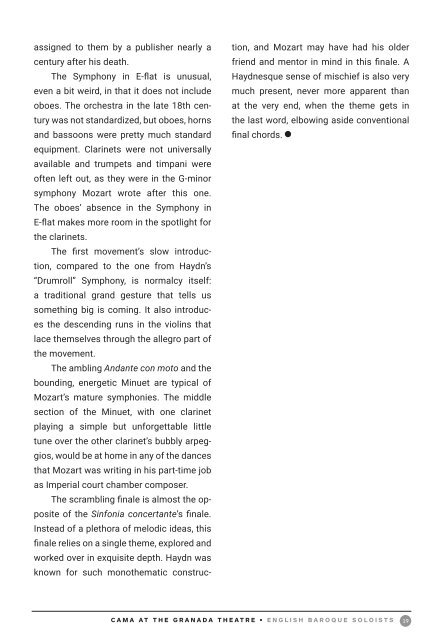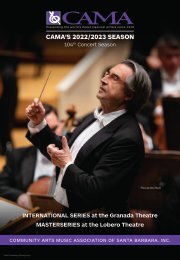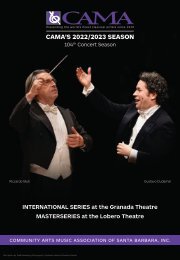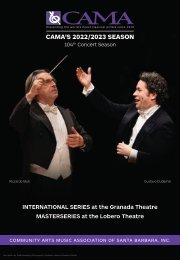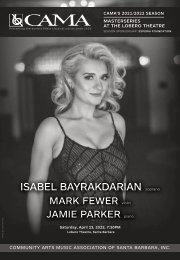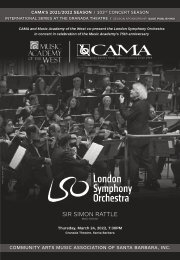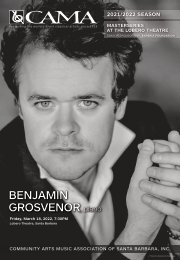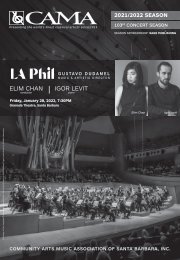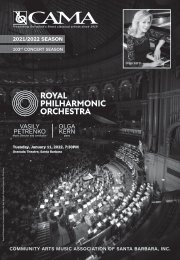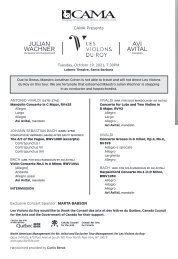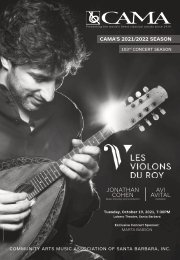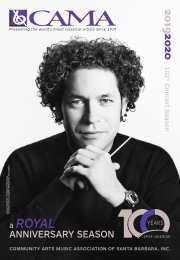CAMA Presents English Baroque Soloists ⫽ John Eliot Gardiner, conductor ⫽ Tuesday, April 12, 2022 ⫽ The Granada Theatre, Santa Barbara, California ⫽ 7:30PM
TUESDAY, APRIL 12, 2022, 7:30PM ENGLISH BAROQUE SOLOISTS JOHN ELIOT GARDINER, conductor Kati Debretzeni, violin Fanny Paccoud, viola Almost inexcusably absent from the pantheon of great conductors appearing in Santa Barbara during CAMA’s long history, John Eliot Gardiner will at last grace the Granada stage directing the English Baroque Soloists, the preeminent period-instrument chamber ensemble founded by the maestro himself in 1978. Arguably the foremost living interpreter of 17th‑ and 18th‑century choral and orchestral repertoire, John Eliot Gardiner is also the Founder and Director of the Monteverdi Choir and the Orchestre Révolutionnaire et Romantique. With these and other ensembles, he has recorded more than 250 albums; among them are benchmark recordings of the Monteverdi Vespers and Bach B‑minor Mass, the complete Beethoven symphony cycle on period instruments, and each and every Bach sacred cantata. In his spare time, the prodigious maestro runs an organic farm at Springhead near Fontmell Magna in North Dorset. PROGRAM: HAYDN: Symphony No.103 in E‑flat Major, “The Drumroll,” H.1/103 MOZART: Sinfonia Concertante for Violin, Viola and Orchestra in E‑flat Major, K.364 (320d) MOZART: Symphony No.39 in E‑flat Major, K.543
TUESDAY, APRIL 12, 2022, 7:30PM
ENGLISH BAROQUE SOLOISTS
JOHN ELIOT GARDINER, conductor
Kati Debretzeni, violin
Fanny Paccoud, viola
Almost inexcusably absent from the pantheon of great conductors appearing in Santa Barbara during CAMA’s long history, John Eliot Gardiner will at last grace the Granada stage directing the English Baroque Soloists, the preeminent period-instrument chamber ensemble founded by the maestro himself in 1978. Arguably the foremost living interpreter of 17th‑ and 18th‑century choral and orchestral repertoire, John Eliot Gardiner is also the Founder and Director of the Monteverdi Choir and the Orchestre Révolutionnaire et Romantique. With these and other ensembles, he has recorded more than 250 albums; among them are benchmark recordings of the Monteverdi Vespers and Bach B‑minor Mass, the complete Beethoven symphony cycle on period instruments, and each and every Bach sacred cantata. In his spare time, the prodigious maestro runs an organic farm at Springhead near Fontmell Magna in North Dorset.
PROGRAM:
HAYDN: Symphony No.103 in E‑flat Major, “The Drumroll,” H.1/103
MOZART: Sinfonia Concertante for Violin, Viola and Orchestra in E‑flat Major, K.364 (320d)
MOZART: Symphony No.39 in E‑flat Major, K.543
Create successful ePaper yourself
Turn your PDF publications into a flip-book with our unique Google optimized e-Paper software.
assigned to them by a publisher nearly a<br />
century after his death.<br />
The Symphony in E‐flat is unusual,<br />
even a bit weird, in that it does not include<br />
oboes. The orchestra in the late 18th century<br />
was not standardized, but oboes, horns<br />
and bassoons were pretty much standard<br />
equipment. Clarinets were not universally<br />
available and trumpets and timpani were<br />
often left out, as they were in the G‐minor<br />
symphony Mozart wrote after this one.<br />
The oboes’ absence in the Symphony in<br />
E‐flat makes more room in the spotlight for<br />
the clarinets.<br />
The first movement’s slow introduction,<br />
compared to the one from Haydn’s<br />
“Drumroll” Symphony, is normalcy itself:<br />
a traditional grand gesture that tells us<br />
something big is coming. It also introduces<br />
the descending runs in the violins that<br />
lace themselves through the allegro part of<br />
the movement.<br />
The ambling Andante con moto and the<br />
bounding, energetic Minuet are typical of<br />
Mozart’s mature symphonies. The middle<br />
section of the Minuet, with one clarinet<br />
playing a simple but unforgettable little<br />
tune over the other clarinet’s bubbly arpeggios,<br />
would be at home in any of the dances<br />
that Mozart was writing in his part‐time job<br />
as Imperial court chamber composer.<br />
The scrambling finale is almost the opposite<br />
of the Sinfonia concertante’s finale.<br />
Instead of a plethora of melodic ideas, this<br />
finale relies on a single theme, explored and<br />
worked over in exquisite depth. Haydn was<br />
known for such monothematic construction,<br />
and Mozart may have had his older<br />
friend and mentor in mind in this finale. A<br />
Haydnesque sense of mischief is also very<br />
much present, never more apparent than<br />
at the very end, when the theme gets in<br />
the last word, elbowing aside conventional<br />
final chords.<br />
<strong>CAMA</strong> AT THE GRANADA THEATRE • ENGLISH BAROQUE SOLOISTS<br />
19


